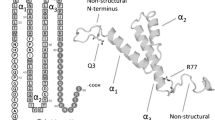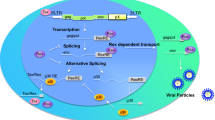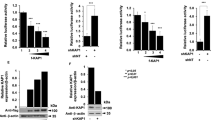Abstract
A greater understanding of the interaction between HIV and host signaling pathways that restrict virus production may lead to new methods to purge virus from latent reservoirs and enhance survival/function of cells targeted by HIV. This review highlights the role of the Wnt/β-catenin pathway as a host factor that represses HIV replication in multiple targets, especially those relevant to HIV in the central nervous system.




Similar content being viewed by others
References
Alvarez G, Munoz-Montano JR, Satrustegui J, Avila J, Bogonez E, Diaz-Nido J (2002) Regulation of tau phosphorylation and protection against beta-amyloid-induced neurodegeneration by lithium. Possible implications for Alzheimer's disease. Bipolar Disord 4(3):153–165
Alvarez-Buylla A, Lim DA (2004) For the long run: maintaining germinal niches in the adult brain. Neuron 41(5):683–686
Angers S, Moon RT (2009) Proximal events in Wnt signal transduction. Nat Rev Mol Cell Biol 10(7):468–477
Archin NM, Eron JJ, Palmer S, Hartmann-Duff A, Martinson JA, Wiegand A, Bandarenko N, Schmitz JL, Bosch RJ, Landay AL, Coffin JM, Margolis DM (2008) Valproic acid without intensified antiviral therapy has limited impact on persistent HIV infection of resting CD4+ T cells. AIDS 22(10):1131–1135
Arnold S, Beyer C (2009) Neuroprotection by estrogen in the brain: the mitochondrial compartment as presumed therapeutic target. J Neurochem 110(1):1–11
Borjabad A, Brooks AI, Volsky DJ (2010) Gene expression profiles of HIV-1-infected glia and brain: toward better understanding of the role of astrocytes in HIV-1-associated neurocognitive disorders. J Neuroimmune Pharmacol 5(1):44–62
Brass AL, Dykxhoorn DM, Benita Y, Yan N, Engelman A, Xavier RJ, Lieberman J, Elledge SJ (2008) Identification of host proteins required for HIV infection through a functional genomic screen. Science 319(5865):921–926
Canki M, Thai JN, Chao W, Ghorpade A, Potash MJ, Volsky DJ (2001) Highly productive infection with pseudotyped human immunodeficiency virus type 1 (HIV-1) indicates no intracellular restrictions to HIV-1 replication in primary human astrocytes. J Virol 75(17):7925–7933
Carroll-Anzinger D, Al-Harthi L (2006) Gamma interferon primes productive human immunodeficiency virus infection in astrocytes. J Virol 80(1):541–544
Carroll-Anzinger D, Kumar A, Adarichev V, Kashanchi F, Al-Harthi L (2007) Human immunodeficiency virus-restricted replication in astrocytes and the ability of gamma interferon to modulate this restriction are regulated by a downstream effector of the Wnt signaling pathway. J Virol 81(11):5864–5871
Cerpa W, Godoy JA, Alfaro I, Farias GG, Metcalfe MJ, Fuentealba R, Bonansco C, Inestrosa NC (2008) Wnt-7a modulates the synaptic vesicle cycle and synaptic transmission in hippocampal neurons. J Biol Chem 283(9):5918–5927
Chairoungdua A, Smith DL, Pochard P, Hull M, Caplan MJ (2010) Exosome release of beta-catenin: a novel mechanism that antagonizes Wnt signaling. J Cell Biol 190(6):1079–1091
Chen J, Park CS, Tang SJ (2006) Activity-dependent synaptic Wnt release regulates hippocampal long term potentiation. J Biol Chem 281(17):11910–11916
Chuang DM (2005) The antiapoptotic actions of mood stabilizers: molecular mechanisms and therapeutic potentials. Ann NY Acad Sci 1053:195–204
Churchill MJ, Wesselingh SL, Cowley D, Pardo CA, McArthur JC, Brew BJ, Gorry PR (2009) Extensive astrocyte infection is prominent in human immunodeficiency virus-associated dementia. Ann Neurol 66(2):253–258
Correia SC, Santos RX, Cardoso S, Carvalho C, Santos MS, Oliveira CR, Moreira PI (2010) Effects of estrogen in the brain: is it a neuroprotective agent in Alzheimer's disease? Curr Aging Sci 3(2):113–126
Cselenyi CS, Lee E (2008) Context-dependent activation or inhibition of Wnt-beta-catenin signaling by Kremen. Sci Signal 1(8):10
Davis EK, Zou Y, Ghosh A (2008) Wnts acting through canonical and noncanonical signaling pathways exert opposite effects on hippocampal synapse formation. Neural Dev 3:32
De Ferrari GV, Chacon MA, Barria MI, Garrido JL, Godoy JA, Olivares G, Reyes AE, Alvarez A, Bronfman M, Inestrosa NC (2003) Activation of Wnt signaling rescues neurodegeneration and behavioral impairments induced by beta-amyloid fibrils. Mol Psychiatry 8(2):195–208
DeCarolis NA, Wharton KA Jr, Eisch AJ (2008) Which way does the Wnt blow? Exploring the duality of canonical Wnt signaling on cellular aging. BioEssays 30(2):102–106
Di Rienzo AM, Aloisi F, Santarcangelo AC, Palladino C, Olivetta E, Genovese D, Verani P, Levi G (1998) Virological and molecular parameters of HIV-1 infection of human embryonic astrocytes. Arch Virol 143(8):1599–1615
Dou H, Ellison B, Bradley J, Kasiyanov A, Poluektova LY, Xiong H, Maggirwar S, Dewhurst S, Gelbard HA, Gendelman HE (2005) Neuroprotective mechanisms of lithium in murine human immunodeficiency virus-1 encephalitis. J Neurosci 25(37):8375–8385
Everall IP, Bell C, Mallory M, Langford D, Adame A, Rockestein E, Masliah E (2002) Lithium ameliorates HIV-gp120-mediated neurotoxicity. Mol Cell Neurosci 21(3):493–501
Farias G, Godoy J, Hernandez F, Avila J, Fisher A, Inestrosa N (2004) M1 muscarinic receptor activation protects neurons from beta-amyloid toxicity. A role for Wnt signaling pathway. Neurobiol Dis 17(2):337–348
Gallicchio VS, Cibull ML, Hughes NK, Tse KF (1993) Effect of lithium in murine immunodeficiency virus infected animals. Pathobiology 61(3–4):216–221
Garrido J, Godoy J, Alvarez A, Bronfman M, Inestrosa N (2002) Protein kinase C inhibits amyloid beta peptide neurotoxicity by acting on members of the Wnt pathway. FASEB J 16(14):1982–1984
Gogolla N, Galimbert I, Deguchi Y, Caroni P (2009) Wnt signaling mediates experience-related regulation of synapse numbers and mossy fiber connectivities in the adult hippocampus. Neuron 62(4):510–525
Gould TD, Manji HK (2002) The Wnt signaling pathway in bipolar disorder. Neuroscientist 8(5):497–511
Hassler C, Cruciat CM, Huang YL, Kuriyama S, Mayor R, Niehrs C (2007) Kremen is required for neural crest induction in Xenopus and promotes LRP6-mediated Wnt signaling. Development 134(23):4255–4263
Hedgepeth CM, Conrad LJ, Zhang J, Huang HC, Lee VM, Klein PS (1997) Activation of the Wnt signaling pathway: a molecular mechanism for lithium action. Dev Biol 185(1):82–91
Himmerich H, Koethe D, Schuld A, Yassouridis A, Pollmacher T (2005) Plasma levels of leptin and endogenous immune modulators during treatment with carbamazepine or lithium. Psychopharmacology (Berl) 179(2):447–451
Inestrosa N, Toledo E (2008) The role of Wnt signaling in neuronal dysfunction in Alzheimer’s Disease. Mol Neurodegener 3:9
Inestrosa NC, Arenas E (2010) Emerging roles of Wnts in the adult nervous system. Nat Rev Neurosci 11(2):77–86
Inestrosa NC, Urra S, Colombres M (2004) Acetylcholinesterase (AChE)–amyloid–beta-peptide complexes in Alzheimer's disease. The Wnt signaling pathway. Curr Alzheimer Res 1(4):249–254
Ishitani T, Ninomiya-Tsuji J, Nagai S, Nishita M, Meneghini M, Barker N, Waterman M, Bowerman B, Clevers H, Shibuya H, Matsumoto K (1999) The TAK1-NLK-MAPK-related pathway antagonizes signalling between beta-catenin and transcription factor TCF. Nature 399(6738):798–802
Ji Y, Lu Y, Yang F, Shen W, Tang TT, Feng L, Duan S, Lu B (2010) Acute and gradual increases in BDNF concentration elicit distinct signaling and functions in neurons. Nat Neurosci 13(3):302–309
Jin T, Fantus IG, Sun J (2008) Wnt and beyond Wnt: multiple mechanisms control the transcriptional property of beta-catenin. Cell Signal 20(10):1697–1704
Jonathan Ryves W, Dalton EC, Harwood AJ, Williams RS (2005) GSK-3 activity in neocortical cells is inhibited by lithium but not carbamazepine or valproic acid. Bipolar Disord 7(3):260–265
Klein PS, Melton DA (1996) A molecular mechanism for the effect of lithium on development. Proc Natl Acad Sci USA 93(16):8455–8459
Kouzmenko AP, Takeyama K, Ito S, Furutani T, Sawatsubashi S, Maki A, Suzuki E, Kawasaki Y, Akiyama T, Tabata T, Kato S (2004) Wnt/beta-catenin and estrogen signaling converge in vivo. J Biol Chem 279(39):40255–40258
Kumar A, Zloza A, Moon RT, Watts J, Tenorio AR, Al-Harthi L (2008) Active beta-catenin signaling is an inhibitory pathway for human immunodeficiency virus replication in peripheral blood mononuclear cells. J Virol 82(6):2813–2820
Lane TE, Buchmeier MJ, Watry DD, Fox HS (1996) Expression of inflammatory cytokines and inducible nitric oxide synthase in brains of SIV-infected rhesus monkeys: applications to HIV-induced central nervous system disease. Mol Med 2(1):27–37
Lau LT, Yu AC (2001) Astrocytes produce and release interleukin-1, interleukin-6, tumor necrosis factor alpha and interferon-gamma following traumatic and metabolic injury. J Neurotrauma 18(3):351–359
Letendre SL, Woods SP, Ellis RJ, Atkinson JH, Masliah E, van den Brande G, Durelle J, Grant I, Everall I (2006) Lithium improves HIV-associated neurocognitive impairment. AIDS 20(14):1885–1888
Li Z, Tan F, Thiele CJ (2007) Inactivation of glycogen synthase kinase-3beta contributes to brain-derived neutrophic factor/TrkB-induced resistance to chemotherapy in neuroblastoma cells. Mol Cancer Ther 6(12 Pt 1):3113–3121
Liao G, Tao Q, Kofron M, Chen JS, Schloemer A, Davis RJ, Hsieh JC, Wylie C, Heasman J, Kuan CY (2006) Jun NH2-terminal kinase (JNK) prevents nuclear beta-catenin accumulation and regulates axis formation in Xenopus embryos. Proc Natl Acad Sci USA 103(44):16313–16318
Liu Y, Liu H, Kim BO, Gattone VH, Li J, Nath A, Blum J, He JJ (2004) CD4-independent infection of astrocytes by human immunodeficiency virus type 1: requirement for the human mannose receptor. J Virol 78(8):4120–4133
Maggirwar SB, Tong N, Ramirez S, Gelbard HA, Dewhurst S (1999) HIV-1 Tat-mediated activation of glycogen synthase kinase-3beta contributes to Tat-mediated neurotoxicity. J Neurochem 73(2):578–586
Maguschak KA, Ressler KJ (2008) Beta-Catenin is required for memory consolidation. Nat Neurosci 11(11):1319–1326
Malaterre J, Ramsay RG, Mantamadiotis T (2007) Wnt-Frizzled signalling and the many paths to neural development and adult brain homeostasis. Front Biosci 12:492–506
Mao B, Wu W, Davidson G, Marhold J, Li M, Mechler BM, Delius H, Hoppe D, Stannek P, Walter C, Glinka A, Niehrs C (2002) Kremen proteins are Dickkopf receptors that regulate Wnt/beta-catenin signalling. Nature 417(6889):664–667
Murase S, Mosser E, Schuman EM (2002) Depolarization drives beta-catenin into neuronal spines promoting changes in synaptic structure and function. Neuron 35(1):91–105
Narasipura SD, Kashanchi F, Al-Harthi L (2010) beta-Catenin/TCF-4-mediated repression of HIV replication. In: HIV biology and pathogenesis Keystone Symposia, Santa Fe, New Mexico, USA. Abstract #302
Nath A, Hartloper V, Furer M, Fowke KR (1995) Infection of human fetal astrocytes with HIV-1: viral tropism and the role of cell to cell contact in viral transmission. J Neuropathol Exp Neurol 54(3):320–330
Neil SJ, Aasa-Chapman MM, Clapham PR, Nibbs RJ, McKnight A, Weiss RA (2005) The promiscuous CC chemokine receptor D6 is a functional coreceptor for primary isolates of human immunodeficiency virus type 1 (HIV-1) and HIV-2 on astrocytes. J Virol 79(15):9618–9624
Orandle MS, MacLean AG, Sasseville VG, Alvarez X, Lackner AA (2002) Enhanced expression of proinflammatory cytokines in the central nervous system is associated with neuroinvasion by simian immunodeficiency virus and the development of encephalitis. J Virol 76(11):5797–5802
Permanyer M, Ballana E, Este JA (2010) Endocytosis of HIV: anything goes. Trends Microbiol 18(12):543–551
Pumfery A, Deng L, Maddukuri A, de la Fuente C, Li H, Wade J, Lambert P, Kumar A, Kashanchi F (2003) Chromatin remodeling and modification during HIV-1 Tat-activated transcription. Curr HIV Res 1:261–274
Rao AS, Kremenevskaja N, Resch J, Brabant G (2005) Lithium stimulates proliferation in cultured thyrocytes by activating Wnt/beta-catenin signalling. Eur J Endocrinol 153(6):929–938
Rong L, Perelson AS (2009) Modeling HIV persistence, the latent reservoir, and viral blips. J Theor Biol 260(2):308–331
Rossi A, Mukerjee R, Ferrante P, Khalili K, Amini S, Sawaya BE (2006) Human immunodeficiency virus type 1 Tat prevents dephosphorylation of Sp1 by TCF-4 in astrocytes. J Gen Virol 87(Pt 6):1613–1623
Saadeddin A, Babaei-Jadidi R, Spencer-Dene B, Nateri AS (2009) The links between transcription, beta-catenin/JNK signaling, and carcinogenesis. Mol Cancer Res 7(8):1189–1196
Salim A, Ratner L (2008) Modulation of beta-catenin and E-cadherin interaction by Vpu increases human immunodeficiency virus type 1 particle release. J Virol 82(8):3932–3938
Sarkar S, Floto RA, Berger Z, Imarisio S, Cordenier A, Pasco M, Cook LJ, Rubinsztein DC (2005) Lithium induces autophagy by inhibiting inositol monophosphatase. J Cell Biol 170(7):1101–1111
Schou M (1988) Effects of long-term lithium treatment on kidney function: an overview. J Psychiatr Res 22(4):287–296
Schou M (1989) Long-term treatment with lithium and renal function. A review and reappraisal. Encephale 15(5):437–442
Schweighardt B, Atwood WJ (2001) HIV type 1 infection of human astrocytes is restricted by inefficient viral entry. AIDS Res Hum Retroviruses 17(12):1133–1142
Shapshak P, Duncan R, Minagar A, Rodriguez de la Vega P, Stewart RV, Goodkin K (2004) Elevated expression of IFN-gamma in the HIV-1 infected brain. Front Biosci 9:1073–1081
Smith SM (2005) Valproic acid and HIV-1 latency: beyond the sound bite. Retrovirology 2:56
Staal FJ, Luis TC (2010) Wnt signaling in hematopoiesis: crucial factors for self-renewal, proliferation, and cell fate decisions. J Cell Biochem 109(5):844–849
Thornton TM, Pedraza-Alva G, Deng B, Wood CD, Aronshtam A, Clements JL, Sabio G, Davis RJ, Matthews DE, Doble B, Rincon M (2008) Phosphorylation by p38 MAPK as an alternative pathway for GSK3beta inactivation. Science 320(5876):667–670
Topol L, Jiang X, Choi H, Garrett-Beal L, Carolan PJ, Yang Y (2003) Wnt-5a inhibits the canonical Wnt pathway by promoting GSK-3-independent beta-catenin degradation. J Cell Biol 162(5):899–908
Tornatore C, Nath A, Amemiya K, Major EO (1991) Persistent human immunodeficiency virus type 1 infection in human fetal glial cells reactivated by T-cell factor(s) or by the cytokines tumor necrosis factor alpha and interleukin-1 beta. J Virol 65(11):6094–6100
Varela-Nallar L, Grabowski CP, Alfaro IE, Alvarez AR, Inestrosa NC (2009) Role of the Wnt receptor Frizzled-1 in presynaptic differentiation and function. Neural Dev 4:41
Vijaykumar TS, Nath A, Chauhan A (2008) Chloroquine mediated molecular tuning of astrocytes for enhanced permissiveness to HIV infection. Virology 381(1):1–5
White BD, Nathe RJ, Maris DO, Nguyen NK, Goodson JM, Moon RT, Horner PJ (2010) beta-Catenin signaling increases in proliferating NG2+ progenitors and astrocytes during post-traumatic gliogenesis in the adult brain. Stem Cells 28(2):297–307
Williams RS, Harwood AJ (2000) Lithium therapy and signal transduction. Trends Pharmacol Sci 21(2):61–64
Wortman B, Darbinian N, Sawaya BE, Khalili K, Amini S (2002) Evidence for regulation of long terminal repeat transcription by Wnt transcription factor TCF-4 in human astrocytic cells. J Virol 76(21):11159–11165
Yu X, Malenka R (2003) Beta-catenin is critical for dendritic morphogenesis. Nat Neurosci 6(11):1169–1177
Acknowledgment
This work was supported by NIH grants R01 NS060632 (LA), R21 A1077329 (LA), PO1 AI082971 (LA), and F31 NS071999 (LJH). The studies were also supported by the Chicago Developmental Center for AIDS Research (D-CFAR, P30 AI 082151), an NIH-funded program supported by NIAID, NCI, NIMH, NIDA, NICHD, NHLBI, and NCCAM.
Conflict of interest
Dr. L. Al-Harthi has a pending US patent on Wnt/β-catenin-based therapeutics.
Author information
Authors and Affiliations
Corresponding author
Rights and permissions
About this article
Cite this article
Henderson, L.J., Al-Harthi, L. Role of β-Catenin/TCF-4 Signaling in HIV Replication and Pathogenesis: Insights to Informing Novel Anti-HIV Molecular Therapeutics. J Neuroimmune Pharmacol 6, 247–259 (2011). https://doi.org/10.1007/s11481-011-9266-7
Received:
Accepted:
Published:
Issue Date:
DOI: https://doi.org/10.1007/s11481-011-9266-7




